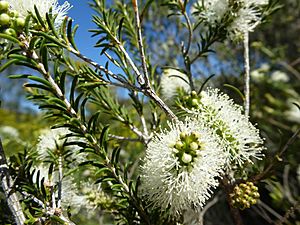Melaleuca rhaphiophylla facts for kids
Quick facts for kids Swamp paperbark |
|
|---|---|
 |
|
| M. rhaphiophylla leaves and flowers | |
| Scientific classification | |
| Genus: |
Melaleuca
|
| Species: |
rhaphiophylla
|
The Swamp Paperbark (scientific name: Melaleuca rhaphiophylla) is a special plant that belongs to the myrtle family, called Myrtaceae. It grows only in the southwest part of Western Australia. This plant has thin, needle-like leaves and lots of white or yellowish flowers that bloom at different times throughout the year. Just like its name suggests, you can usually find the Swamp Paperbark growing in salty marshes, swamps, or along rivers and streams across a large area of southwestern Australia.
Contents
What Does Swamp Paperbark Look Like?
The Swamp Paperbark is a large bush or a small tree. It can grow up to 10 meters (about 33 feet) tall. It often has many stems and a bushy top with grayish bark that feels like paper.
Leaves, Flowers, and Fruits
Its leaves are soft and grow one after another along the stem. They are usually 8 to 40 millimeters (about 0.3 to 1.6 inches) long and very thin, only 0.5 to 1.5 millimeters (about 0.02 to 0.06 inches) wide. They are shaped like a line, round or oval when you look at them from the end, and they get thinner at the tip, often with a little hook.
The flowers are white to cream colored. They grow in groups or spikes at the ends of most branches. Even after the flowers bloom, the branches keep growing! Sometimes, flowers also appear where the upper leaves meet the stem. These flower clusters can be up to 27 millimeters (about 1 inch) wide and 40 millimeters (about 1.6 inches) long. Each cluster has 4 to 25 smaller groups of three flowers. The petals are small, about 2.5 to 3.5 millimeters (about 0.1 to 0.14 inches) long, and they fall off as the flower gets older. Each flower has five groups of stamens (the parts that hold pollen), and each group has 11 to 25 stamens.
Swamp Paperbark flowers bloom on and off, mostly from May to January. After flowering, the plant produces woody, cup-shaped fruits called capsules. These fruits are 3 to 6 millimeters (about 0.1 to 0.2 inches) long and 5 to 6 millimeters (about 0.2 inches) wide. They grow in clusters along the stem.
Where Swamp Paperbark Grows
You can find this type of melaleuca plant in the areas between Kalbarri and Albany in Western Australia. It likes to grow in sandy or clay soils, sometimes with limestone. It's often found near water, in swamps, and in salty marshes.
Swamp Paperbark and Nature
The Swamp Paperbark is very important for local wildlife. It provides food for many native animals. Because its top is so thick and bushy, it also gives animals a safe place to live. Waterbirds often use these plants, especially since they grow in areas that flood during breeding season. This flooding helps keep predators away from their nests.
The plant's roots are not very deep, which helps to stop the soil from washing away along rivers and streams. They also help to keep the soil stable and trap dirt that might otherwise flow away. In some places, the Swamp Paperbark is having trouble because of a plant called Typha orientalis, which grows back much faster after a fire.
Is Swamp Paperbark Protected?
The Government of Western Australia's Department of Parks and Wildlife says that the Swamp Paperbark is "not threatened." This means it's not currently in danger of disappearing.
Growing Swamp Paperbark in Gardens
This type of melaleuca is a good plant to grow if you have a damp spot in your garden. It can also be used to create a screen or hedge if you trim it regularly. It's easy to collect seeds from the unopened fruits on the plant. You can then grow them in small pots or plant them directly into the soil.
Images for kids
-
M. rhaphiophylla growing near Geraldton




